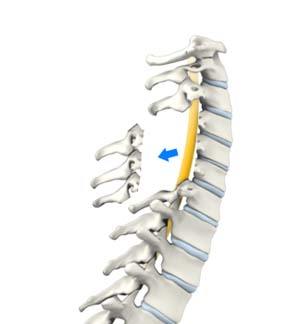
Disease Overview
Degeneration of the facet joints and intervertebral discs results in narrowing of the spinal canal known as spinal stenosis. In addition, the arthritic facet joints become bulkier and consume the space available for the nerve roots. Besides, bony outgrowths also known as bone spurs or bone osteophytes can also narrow the spinal canal. This condition of spinal stenosis, narrowing of the spinal canal, puts pressure on the spinal nerves and spinal cord, causing symptoms such as neck pain, tingling sensation, numbness or weakness that extends to the shoulders, arms and/or hands, and bowel or bladder impairment.
What is Cervical Laminectomy?
Laminectomy refers to the removal or cutting of the lamina (roof) of the vertebral bones to provide space for the nerves to exit from the spine.
A cervical laminectomy is an operative procedure that involves the removal of bone at the neck (cervical spine) region to relieve pressure on the spinal nerves. It can also be performed to relieve the symptoms of the narrowed spinal canal known as spinal stenosis.
Objective of Cervical Laminectomy
The objective of cervical laminectomy is to relieve pressure on the spinal nerves by removing the part of the lamina that is putting pressure on the nerves.
Diagnostic Tests before Cervical Laminectomy
Your surgeon recommends you for cervical laminectomy after examining your spine, medical history, and imaging results of cervical vertebrae from X-ray, CT (computed tomography) scan or MRI (magnetic resonance imaging).
Indication for Cervical Laminectomy
Surgery is recommended only after non-surgical treatment approaches fail to relieve symptoms after a reasonable period.
Cervical Laminectomy Procedure
- Cervical laminectomy is performed with you resting on your stomach, under general anesthesia.
- Your surgeon makes a small incision near the center of the back of your neck and approaches the neck bones (cervical vertebrae) by moving the soft tissues and muscles apart.
- Then, the total lamina or a part of the lamina is removed to relieve the compression.
- Other compression sources such as bone spurs and/or disc fragments (discectomy) are also removed.
- After the procedure, your surgeon brings back the soft tissues and muscles to their normal position and closes the incision.
- In some instances, spinal fusion may also be performed along with the cervical laminectomy, which involves placing bone graft or a bone graft substitute between two affected vertebrae to allow bone growth between the vertebral bodies.
- The bone graft acts as a medium for binding the two vertebral bones and grows as a single vertebra which stabilizes the spine.
- It also helps to maintain the normal disc height.
Postoperative Recovery following Cervical Laminectomy
A specific postoperative recovery or exercise plan will be prescribed by your physician to help you return to normal activity at the earliest. After surgery, your symptoms may improve immediately or gradually over a course of time. The duration of hospital stay depends on this treatment plan.
In a few instances, surgery may also be performed on an outpatient basis. You will be able to wake up and walk by the end of the first day after the surgery. Your return to work will depend on your body’s healing status and the type of work/activity that you plan to resume. Discuss with your spinal surgeon and follow the instructions for optimized healing and appropriate recovery after the procedure.
Risks and Complications of Cervical Laminectomy
All surgeries carry certain risks and it is important to understand the risks of the procedure to make an informed decision to go ahead with the surgery. In addition to the anesthetic complications, spinal surgery is associated with some potential risks such as:
- Infection
- Blood loss
- Blood clots
- Nerve damage
- Bowel and bladder problems
- Failure to fuse the vertebral bones with the bone graft (fusion failure), requiring additional surgery



